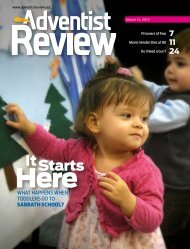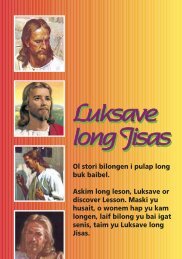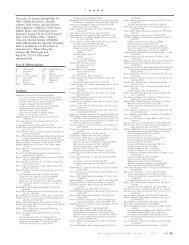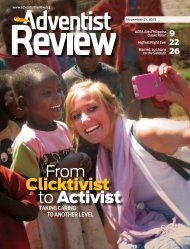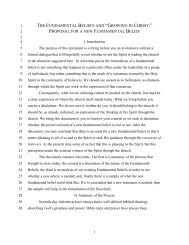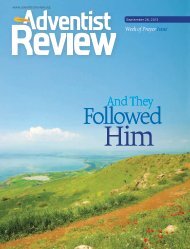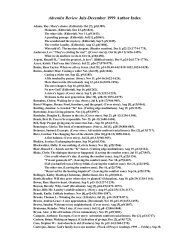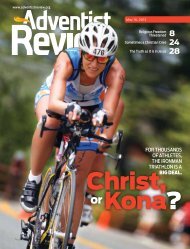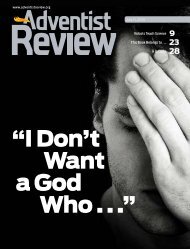Download PDF - Adventist Review
Download PDF - Adventist Review
Download PDF - Adventist Review
- No tags were found...
Create successful ePaper yourself
Turn your PDF publications into a flip-book with our unique Google optimized e-Paper software.
le what I have come to call a “belief<br />
grid.” Some of these beliefs are at a low<br />
level at which we feel at liberty to use our<br />
discretion, while others are at a very high<br />
level, which might even involve us in lifeor-death<br />
decisions. As we face the daily<br />
task of living, we filter the opportunities<br />
or difficulties that arise through our<br />
belief grids in order to come to lifedirecting<br />
decisions. This whole function<br />
is protected by what we commonly call<br />
our “conscience.” For humans, then,<br />
intrinsic religion is not a play zone;<br />
instead, it’s a zone of great seriousness,<br />
because we know that if we do well by<br />
our beliefs, we are able to retain a sense<br />
of integrity. If we become duplicitous, we<br />
can diminish ourselves significantly.<br />
Another researcher, Kurt Lewin, 6 coined<br />
a name for this inner dimension: our “life<br />
space.” 7 The visual image this name suggests<br />
is a “space” inside us in which life<br />
happens. And the life that happens in the<br />
inner space ends up influencing and<br />
guiding what is seen on the outside.<br />
Allport and Ross developed a list of<br />
things that they saw domiciled in the<br />
life space, which include highly personal<br />
beliefs about life: identity and<br />
sexuality, family and origin, expectations<br />
of self and others, attitudes<br />
ality. Interestingly, Allport and Ross link<br />
identity and sexuality together as a pair,<br />
which suggests an inherent understanding<br />
that identity and sexuality are<br />
parts of our basic makeup—part of who<br />
we perceive ourselves to be.<br />
Embedded in our belief grid and<br />
linked to our sense of personhood is<br />
our sexuality, domiciled within the<br />
intrinsic realm of the human mind in<br />
which we hold things sacred to us.<br />
Implications of Infringement<br />
Since sexuality is part of the intrinsic<br />
zone in which we hold sacred things, if<br />
it is not properly reverenced and is<br />
treated tritely a person will feel diminished<br />
and infringed upon. The misuse<br />
of sexuality or the infringement upon it<br />
by someone else becomes both offensive<br />
and damaging, because the inner sanctum<br />
of life was trampled upon. People<br />
who have been victimized sexually, for<br />
example, are often overtaken by a sense<br />
of diminished personhood. It’s not<br />
unusual for a victim of sexual mistreatment<br />
to exhibit a sense of self-loathing,<br />
even to the point of depression.<br />
When such a person realizes the<br />
depths of the offense they have suffered,<br />
they sometimes become fearless,<br />
THERE’S A DEEPER DIMENSION UNDERLYING<br />
HUMAN SEXUALITY THAN WHAT WE COMMONLY<br />
toward personal risk-taking, life goals<br />
and relationships, personal hopes and<br />
dreams, and ideas we use to make sense<br />
of life. 8 They form the inner essence of<br />
our lives and are “sacred” to us in that<br />
we hold them in such high esteem that<br />
we revere them. They not only give us a<br />
sense of morality, direction, and purpose<br />
but also our sense of identity. Who<br />
you perceive yourself to be is derived<br />
from these very ideas.<br />
The order in which Allport and Ross<br />
set things down is also intriguing. Identity<br />
is mentioned first, because our<br />
sense of who we are is foundational to<br />
life. The second item on the list is sexu-<br />
UNDERSTAND.<br />
unafraid to confront the perpetrators of<br />
the deeds done against them. They<br />
struggle to feel whole again until they<br />
have done so. Their very sense of being<br />
clamors for justice and restitution.<br />
Reverencing Sexuality<br />
If, indeed, sexuality is part of the intrinsic<br />
zone, or life space, and linked to identity,<br />
then it should be reverenced, protected,<br />
carefully tended, and held as<br />
sacred. I believe this is why Paul wrote the<br />
counsel he did, and why for so many centuries<br />
societies have attempted to protect<br />
sexuality by the establishment of taboos.<br />
Certainly, those taboos have not all been<br />
good, but their existence testifies to an<br />
inherent human understanding of a certain<br />
“sacredness” to sexuality that is missing<br />
almost entirely from current culture.<br />
On the positive side, because sexuality<br />
is domiciled in the life space, when it’s<br />
respected, preserved, and guarded as<br />
something sacred, it can become the<br />
means of a deep bonding between two<br />
people. When two people who have preserved<br />
their sense of sexual integrity<br />
consent, in love, to willingly offer themselves<br />
to each other, it’s not just their<br />
physical bodies that touch, but their<br />
intrinsic dimensions as well. Love and<br />
volition allow the intrinsic dimensions<br />
to open without any sense of infringement.<br />
Their sexuality becomes an instrument<br />
of a profoundly intimate bond that<br />
is theirs alone to enjoy and be blessed by.<br />
It is this inner aspect of human sexuality,<br />
the idea that personhood and sexuality<br />
are linked, that is all but gone from popular<br />
culture. This is what leaves us with<br />
such a deficit in spite of all our knowledge<br />
and information. It’s an aspect that Christians<br />
are well situated to address powerfully,<br />
if we would but reverence the gift<br />
God has given us by way of this very complicated<br />
thing we call sexuality. n<br />
1<br />
Mark Regnerus and Jeremy Uecker, Premarital Sex in<br />
America: How Young Americans Meet, Mate, and Think About<br />
Marrying (Oxford: Oxford University Press, 2011).<br />
2<br />
Quoted from a review in First Things, August/September<br />
2011, p. 53.<br />
3<br />
Ibid., p. 55.<br />
4<br />
Scripture quotations marked ESV are from The Holy<br />
Bible, English Standard Version, copyright © 2001 by<br />
Crossway Bibles, a division of Good News Publishers.<br />
Used by permission. All rights reserved.<br />
5<br />
Harding Journal 9, no. 2 (1990). (This journal was once<br />
associated with Harding Hospital, but is now defunct and<br />
can no longer be found.)<br />
6<br />
Kurt Lewin was a notable person in the field of psychology<br />
and best remembered for his pioneering work in<br />
group dynamics.<br />
7<br />
The idea of “life space” in Lewin’s thinking can be<br />
quite expansive, enough to include all events in a person’s<br />
past, present, and future that help shape and affect them.<br />
But it begins with the internal dimension describing a<br />
person’s motives, values, needs, moods, goals, anxieties,<br />
and ideals. The term is used here in the internal sense.<br />
8<br />
Harding Journal.<br />
DAVID E. THOMAS IS DEAN AND A<br />
PROFESSOR OF THE PRACTICAL<br />
THEOLOGY AND APOLOGETICS<br />
DEPARTMENT AND CHAIR OF THE<br />
FACULTY DEVELOPMENT COMMITTEE<br />
AT WALLA WALLA UNIVERSITY SCHOOL OF THEOLOGY.<br />
26 (554) | www.<strong>Adventist</strong><strong>Review</strong>.org | June 20, 2013





